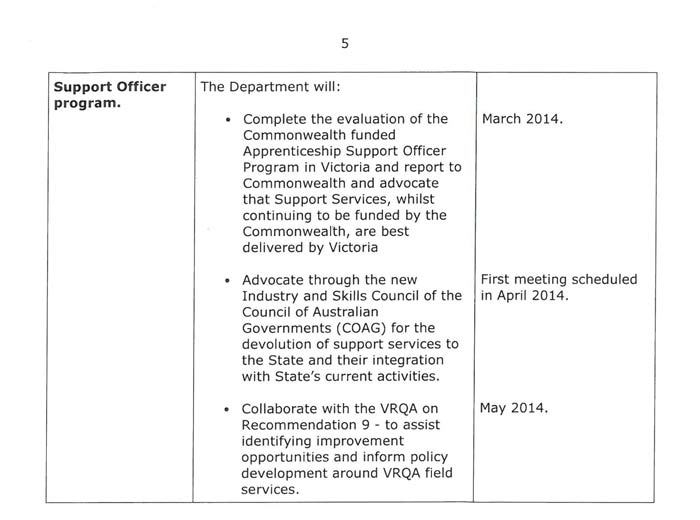Apprenticeship and Traineeship Completion
Overview
Apprenticeships and traineeships combine formal training with employment, allowing individuals to acquire qualifications while supplying Victoria’s vital industries with a skilled workforce. Expenditure on apprenticeships and traineeships has increased by 37 per cent in real terms since 2004.
The audit determined whether the activities of the Department of Education and Early Childhood Development (DEECD) and the Victorian Registration and Qualifications Authority (VRQA) maximise apprenticeship and traineeship completion. It found that while more people are undertaking multiple qualifications—leading to an increase in the total qualifications being completed—the number of individuals completing apprenticeships and traineeships has remained stagnant. Now, as in 2004, a third of people who start an apprenticeship or traineeship will not finish it.
DEECD has a partial and insufficient understanding of how many individuals are completing apprenticeships and traineeships. Without this knowledge, it cannot take effective action to improve completion outcomes.
The VRQA assumed responsibility for regulating apprenticeships and traineeships in 2012. Since then, it has acted to enhance and improve regulation of apprenticeships and traineeships. However, the audit identified a number of areas where further action is required. VRQA has committed to addressing these issues over the next 18 months.
Apprenticeship and Traineeship Completion: Message
Ordered to be printed
VICTORIAN GOVERNMENT PRINTER March 2014
PP No 303, Session 2010–14
President
Legislative Council
Parliament House
Melbourne
Speaker
Legislative Assembly
Parliament House
Melbourne
Dear Presiding Officers
Under the provisions of section 16AB of the Audit Act 1994 , I transmit my report on the audit Apprenticeship and Traineeship Completion..
The audit assessed whether the activities of the Department of Education and Early Childhood Development (DEECD) and the Victorian Registration and Qualifications Authority (VRQA) maximise apprenticeship and traineeship completion.
I found that while investment has increased significantly over the past 10 years, the rate at which people are enrolling in and completing apprenticeships and traineeships has stalled. DEECD does not adequately analyse apprenticeship and traineeship data, limiting its ability to take effective action to understand and improve participation and completion rates.
I also identified shortcomings in VRQA’s regulation of apprenticeship and traineeships. However, VRQA has provided me with a clear commitment to addressing these issues.
Yours faithfully

John Doyle
Auditor-General
12 March 2014
Auditor-General's comments
 John Doyle Auditor-General |
Audit team Kristopher Waring—Sector Director Kate Kuring—Team Leader Elsbeth Stops Jason Cullen Sid Nair Analysts Michele Lonsdale—Engagement Quality Control Reviewer |
Apprenticeships and traineeships combine formal training with employment. They allow individuals to acquire qualifications while supplying skilled workers to Victoria’s key industries. Through these programs mostly young people develop the skills necessary to perform important roles.
Evidence suggests that individuals who complete apprenticeships and traineeships are more likely to be employed, more likely to earn a higher salary and more likely to have full time rather than part time employment, than those who don't complete.
The Department of Education and Early Childhood Development (DEECD) has worked to encourage people to undertake apprenticeships and traineeships. However, there are no more people starting apprenticeships and traineeships now than there were in 2004, and there has been no real improvement in the proportion of apprentices and trainees who actually complete their qualification. Now, as was the case in 2004, a third of people who pursue apprenticeships and traineeships do not complete them.
Meanwhile, expenditure on apprenticeships and traineeships has increased by the equivalent of 37 per cent over the same period, reaching $311 million in 2012.
A major barrier to DEECD’s success in influencing completion rates is its partial and insufficient understanding and use of apprenticeship and traineeship data. This poor utilisation of available data is a common finding across most of the recent audits my office has undertaken of DEECD. Understanding and acting on this evidence is the crucial next step.
DEECD has started work to improve data collection and reporting. Having invested in collecting this data, it needs to use it to fully understand and improve participation and completion levels.
If implemented fully, my recommendations to DEECD will improve its understanding of apprenticeship and traineeship activity and its ability to positively influence participation and completion.
I am encouraged that DEECD has outlined the actions it plans to take to address my recommendations. However, the issues I have identified are significant and I am not confident that the actions that DEECD proposes to take will make the sustained and significant improvement to apprenticeship and traineeship outcomes that is required.
The audit also examined the activities of the Victorian Registration and Qualifications Authority (VRQA). VRQA recently assumed responsibility for regulating apprenticeships and traineeships. I was encouraged to find that it had identified and acted on risks and issues associated with the established regulatory model. However, my audit also identified a range of residual issues which had the capacity to impair apprenticeship and traineeship completions.
I am pleased to note that VRQA acknowledged these issues at an early stage of the audit. I am also encouraged by VRQA’s cooperative and proactive approach towards articulating how it intends to address these issues. The VRQA board has assured me that implementing these recommendations will be a high priority and I look forward to following up their progress in the future.
I would like to thank the staff of DEECD and VRQA for their assistance and cooperation during this audit.

John Doyle
Auditor-General
March 2014
Audit Summary

Apprenticeships and traineeships are a central part of vocational education and training and have a long history in Victoria. They combine training with employment, giving people the opportunity to acquire a qualification while also developing important work skills. Apprenticeships and traineeships require an investment of time and money from:
- apprentices and trainees
- employers, as they develop the skills of their people
- governments, which fund training and incentives.
The qualifications and work experience people gain by completing apprenticeships and traineeships can result in more secure and higher-paid employment for those individuals, and a more productive society.
There are small differences between apprenticeships and traineeships, particularly around the contractual arrangements that govern them. There are also differences in the public and private benefits they provide. Apprenticeships lead to employment in industries vital to the Victorian economy, and produce skills in high demand by employers. Apprenticeship training is therefore perceived to have the highest public value. In contrast, traineeships are for occupations in a variety of industries from hospitality to aged care. Their perceived public value varies according to the specific industry and the level of demand for workers with those skills.
National statistics comparing apprenticeship and traineeship completion rates across all states and territories show that Victoria's completion rate is slightly below the national average.
Conclusions
The total number of apprentice and trainee qualifications completed in Victoria has increased steadily since the government introduced the Victorian Training Guarantee in 2009. Despite this, there are currently no more people undertaking apprenticeships and traineeships than there were 10 years ago. This suggests that there are more people pursuing multiple qualifications, rather than more people entering the system. Developing skills in this way may benefit individuals, however, it is not likely to contribute significantly towards increasing the total supply of skilled workers for Victoria's vital industries.
There is no evidence that the Department of Education and Early Childhood Development's (DEECD) actions have had any impact on the proportion of apprentices or trainees who complete their training. As was the case in 2004, over a third of people who start an apprenticeship or traineeship do not complete it.
DEECD's funding model seeks to encourage participation in apprenticeships above all other vocational education and training qualifications. However, the growth in qualifications attained has almost exclusively been in traineeships. There has been minimal change in apprenticeship participation and completion over time. These are disappointing results given that there has been a 37 per cent increase—in real terms—in funding to apprenticeships and traineeships since 2004.
Prior to receiving the analysis presented in this report, DEECD had only a partial and insufficient understanding of the available information on individual participation and completion. Without it, DEECD cannot make informed decisions to effect sustained improvements to participation and completion.
Given the lack of available data and lack of evidence of initiatives achieving improved outcomes, it is questionable whether the government is achieving value for money from its $311 million annual investment in apprenticeships and traineeships.
The Victorian Registration and Qualifications Authority (VRQA) assumed responsibility for regulating apprenticeships and traineeships in 2012. It has evaluated the risks associated with these new responsibilities and started to address them. In the course of this audit we identified additional risks and challenges which we communicated to VRQA, along with recommended actions to address them. These are detailed in Part 4. VRQA accepted our recommendations and committed to implementing them over the next 12 to 18 months.
Findings
Understanding apprenticeship and traineeship data
DEECD's understanding of apprenticeship and traineeship participation and completion in Victoria is limited. This means it is making decisions without considering information that is critical to driving improvements.
DEECD does not currently:
- systematically monitor the number of individuals commencing and completing apprenticeships and traineeships
- monitor progress against lead indicators to identify emerging trends in completion.
DEECD's lack of data analysis is partly due to issues with the database containing information on Victorian apprenticeships and traineeships. Despite issues with its database being highlighted to DEECD repeatedly over several years, the problems persist.
DEECD has been working with the Commonwealth Government and training providers to improve data collection, including by:
- introducing a Unique Student Identifier for all students undertaking vocational education and training
- developing nationally consistent data protocols and performance indicators for training providers.
This is important work with the potential to significantly improve DEECD's understanding of apprenticeship and traineeship participation and completion. However, it is equally important that DEECD analyse the data it collects to:
- determine the impact of its actions on completion
- inform evidence‑based policies
- drive value for money in government's investment in training.
DEECD has been failing to optimise its own data and without appropriate analysis, improvements to the quality of data collections will not fill the sizable gaps in DEECD's understanding. It is essential that DEECD not just collect, but properly analyse data.
Apprenticeship and traineeship completion in Victoria
In the absence of any robust analysis of the available data by DEECD, VAGO comprehensively analysed data on apprenticeship and traineeship commencement and completion from 2004 to 2012. We determined outcomes in the critical areas of:
- individual participation and completion
- qualification commencement and completion.
We also reviewed funding levels over the same period. The following charts highlight our key findings.
Figure A Selected apprenticeship and traineeship outcomes 2004 to 2012
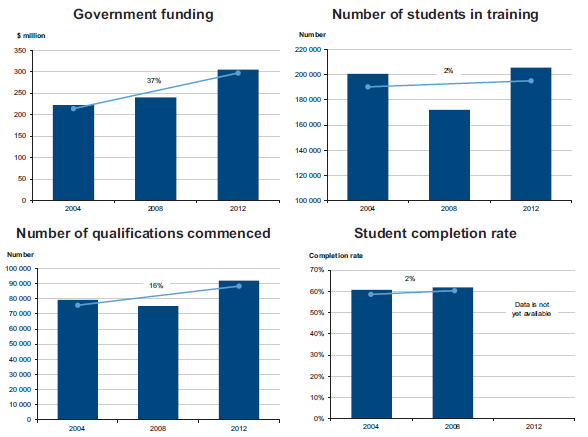
Source: Victorian Auditor-General's Office analysis of Victorian Registration and Qualifications Authority data.
Funding has increased by 37 per cent in real terms, from $227 million in 2004 to $311 million in 2012. During this time, policy reforms were introduced that sought to increase the number of people undertaking vocational education and training of high public value. These reforms encouraged more people to undertake more qualifications. Related to this, the number of qualifications started has increased—16 per cent more qualifications were started in 2012 than 2004. This increase indicates that DEECD is making progress towards this policy objective. Early results also suggest that qualification completion rates are increasing.
By contrast, the number of individuals undertaking and completing apprenticeships and traineeships has stalled. This means more people are pursuing multiple qualifications rather than entering the system in greater numbers. This suggests that DEECD's other, equally important, policy objective of increasing participation is not being met.
The range of qualifications available through apprenticeships and traineeships offer varying levels of public and private benefit. Therefore, it is important to analyse precisely what qualifications are being undertaken and, more importantly, completed to determine whether value for money is being achieved. DEECD does not adequately do this. Our analysis found that:
- apprentice commencements increased slightly in 2009 and 2010, but dipped to below 2004 levels in 2012
- trainee commencements are consistently more than double that of apprenticeships—in 2011 and 2012 traineeship commencements were more than four times greater than apprenticeship commencements
- apprentices had a largely consistent completion rate between 2004 and 2006 but it has declined in recent years
- the trainee completion rate has steadily increased and trainees are now more likely to complete their qualification than apprentices.
DEECD's activities to influence completion
DEECD has worked to develop a good understanding of the broad factors that influence apprenticeship and traineeship completion. It has undertaken eight reviews of different aspects of the apprenticeship and traineeship system since 2009. Through these, it has identified a range of potential areas where targeted programs or intervention could contribute to increasing completions.
In response to this information, it has:
- developed the Apprenticeship Support Officer program, which provides direct support to young, first-year apprentices at risk of disengaging
- advocated strongly to establish a single, continuous point of contact for apprentices and trainees throughout their training.
These actions are positive. However, there are several other areas where reforms or targeted programs were found to have the potential to increase completions, which DEECD has not acted on. DEECD should consider prioritising these activities.
Gaps in DEECD's activity
There is considerable evidence that apprentices' and trainees' experiences in the workplace are among the most influential factors on completion. However, DEECD does not have any programs aimed directly at employers and workplaces. Even though there are limits to how much DEECD can influence this area, the strong relationship between workplace experiences and completion justifies DEECD doing more in this space.
DEECD doesn't routinely analyse why apprentices and trainees cancel their contracts. A 2011 review of cancellations recommended that DEECD monitor cancellation data and develop associated retention strategies. DEECD has not taken any action in response to this recommendation. It has limited insight into:
- why apprentices and trainees cancel
- whether those who cancel before completing go on to further training or employment.
DEECD has recently stopped providing financial incentives to encourage participation in, and completion of, apprenticeships and traineeships. It made this decision without thoroughly reviewing both of its incentive programs and their specific impact on participation and completion in Victoria, despite the conflicting evidence about the efficacy of financial incentives.
Regulation of apprenticeships and traineeships in Victoria
Effective regulation is a key part of a well-functioning training system. It is particularly important for apprentices and trainees, who are often in entry-level roles and new to work, making them potentially vulnerable.
Typically the regulator interacts directly with apprentices, trainees and employers at critical points where the risk of disengaging is at its greatest. This means the regulator has a critical role in supporting the successful completion of apprenticeships and traineeships.
VRQA assumed responsibility for regulating apprenticeships and traineeships in 2012. It acted promptly to identify and respond to risks in the existing regulatory practices. In 2013, it engaged a third party to provide regulatory field services—a key aspect of regulation that involves direct interaction with apprentices, trainees and their employers. This change was intended to remove the conflicts of interest that existed in the previous model and strengthen regulatory oversight. As it is too early to determine the impact of this significant change, VRQA will need to closely monitor its progress going forward.
This audit identified a number of significant outstanding issues that impact on VRQA's ability to effectively regulate apprenticeships and traineeships and facilitate completion. These include:
- fundamental weaknesses in its apprenticeship and traineeship database which compromise regulation and impact DEECD's ability to monitor participation and completion trends
- an absence of formal agreements with other agencies involved in administering apprenticeships and traineeships—such as Australian Apprenticeships Centres—that define roles, responsibilities and expectations
- a poorly developed approach to ensuring employers of apprentices and trainees are fit and proper
- a lack of clear, up-to-date and publicly available information on the regulation of apprenticeships and traineeships.
In the course of this audit, we issued a management letter to the VRQA board seeking its commitment to act on these issues. In particular, we sought assurance that they would address these issues in a timely way. The VRQA board accepted our recommendations and has committed to taking action over the next 18 months.
Recommendations
That the Department of Education and Early Childhood Development:
- collaborate with the Victorian Registration and Qualifications Authority to develop a functional database to replace its existing database, DELTA
- develop and implement a structured process to collect, analyse and report on data including:
- the participation of apprentices and trainees in training, including factors influencing both commencement and completion
- the type and level of training being undertaken, matched against known industry needs
- the destinations and outcomes of apprentices and trainees after they exit the system
- identify strategies to improve the completion rate, including by targeting people who do not complete with their first employer and exit the system
- develop or engender mechanisms to provide support for all apprentices and trainees, pending evaluation of the Apprenticeship Support Officer program.
VRQA has begun actions to address the major risks identified in its 2012 due diligence report, however, this audit identified a range of other issues that are concerning and require prompt action. As previously stated, VAGO wrote to the VRQA board in November 2013 highlighting the identified issues, recommending remedial action and seeking specific advice as to how and when VRQA would address them. VRQA committed to various actions in response to these recommendations, which are included below.
|
Recommendation 5 |
|---|
|
Due to ongoing change over the short to medium term, it is essential that the Victorian Registration and Qualifications Authority document and make publicly available comprehensive information about its regulation of apprenticeships and traineeships to facilitate regulatory compliance and the effective operation of the system. The document should include details of:
|
|
Actions committed to by VRQA |
|
VRQA accepted this recommendation and committed to implementing it by July 2014. |
|
Recommendation 6 |
|
That the Victorian Registration and Qualifications Authority, in collaboration with the Department of Education and Early Childhood Development, prioritise development of a secure register of apprentices and trainees which includes all the information required to meet the Department of Education and Early Childhood Development and the Victorian Registration and Qualifications Authority's needs in relation to planning, policy development and regulation of apprenticeships and traineeships in Victoria. |
|
Actions committed to by VRQA |
|
VRQA accepted this recommendation and committed to implementing it by January 2016. VRQA commented: 'On 13 December 2013 the VRQA's 'DELTA Replacement' project proposal successfully passed through the first DEECD Information Technology Division gateway project. The project is estimated to take two years to complete. During the interim phase, the VRQA will also:
|
|
Recommendation 7 |
|
The Victorian Registration and Qualifications Authority should develop memoranda of understanding—documenting information sharing protocols and roles and responsibilities—with:
|
|
Actions committed to by VRQA |
|
VRQA accepted this recommendation and committed to implementing it by July 2014. |
|
Recommendation 8 |
|
That the Victorian Registration and Qualifications Authority develop a more robust employer approval process that gives due consideration to whether employers are fit and proper. |
|
Actions committed to by VRQA |
|
VRQA accepted this recommendation and committed to implementing it by September 2014. VRQA commented: 'During 2013 this matter has been under active consideration by the Apprenticeship and Traineeship Subcommittee of the board. The VRQA intends to adopt a new employer approval process in 2014.' |
|
Recommendation 9 |
|
That the Victorian Registration and Qualifications Authority, in addition to the monitoring and evaluation required under contract, develop arrangements to regularly analyse information collected through regulatory field services to identify improvement opportunities and inform policy and program development. |
|
Actions committed to by VRQA |
|
VRQA accepted this recommendation and committed to implementing it by January 2014. VRQA commented: 'This has commenced and will form part of reporting to the board in 2014.' |
|
Recommendation 10 |
|
That the Victorian Registration and Qualifications Authority:
|
|
Actions committed to by VRQA |
|
VRQA accepted this recommendation and committed to implementing it by March 2014. VRQA commented: 'Through the Apprenticeships and Traineeships Subcommittee of the board, the current risk framework will be reviewed and updated.' |
Submissions and comments received
Agency views have been considered in reaching our audit conclusions and are represented to the extent relevant and warranted in preparing this report. Their full section 16(3) submissions and comments are included in Appendix B.
1 Background
1.1 Introduction
Apprenticeships and traineeships are a critical component of the vocational education and training system and have a long history in Victoria. They allow people to develop skills through paid work experience and provide formal training that leads to a qualification.
Apprenticeships are typically associated with traditional trades like plumbing, carpentry and automotive mechanics. Historically, apprenticeships were a route for young, unskilled individuals with little or no work experience to gain entry into the workforce and acquire a trade. More recently, mature aged workers changing career or retraining are pursuing apprenticeships.
While apprenticeships lead to a trade, traineeships lead to an occupation. Traineeships were introduced in the 1980s to facilitate entry level employment for young people in a broader range of industries.
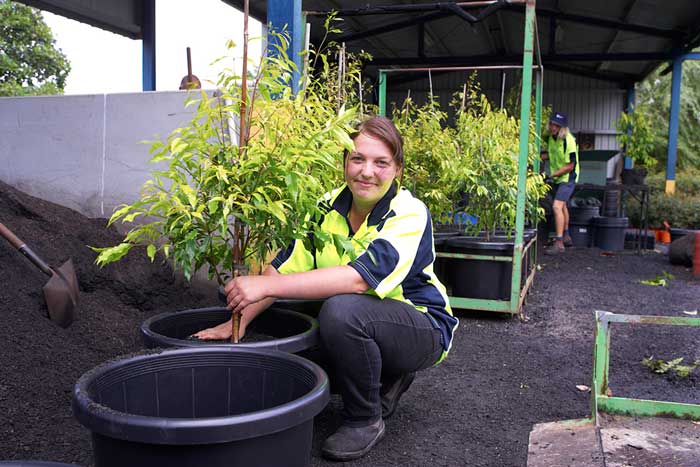
Photograph courtesy of VRQA
The principal difference between apprenticeships and traineeships is the contractual arrangements governing employment. While apprenticeship contracts can only be terminated by the mutual agreement of employer and employee, traineeship contracts can be terminated by either party at any time. Figure 1A provides more information about the differences between apprenticeships and traineeships.
Figure 1A Differences between apprenticeships and traineeships
|
Full time duration |
Qualification level |
Contract terms |
Example qualifications |
|---|---|---|---|
|
Apprenticeships |
|||
|
Three to four years |
Certificate III Certificate IV Diploma Advanced Diploma |
Requires the agreement of both the apprentice and employer to terminate the contract—referred to as mutual consent |
Certificate III in Hospitality Certificate III in Hairdressing Diploma of Dental Technology Certificate IV in Electrical – Air‑conditioning Systems Advanced Diploma of Engineering – Explosion Protection |
|
Traineeships |
|||
|
One to four years |
Certificate II Certificate III Certificate IV Diploma Advanced Diploma |
Either the employer or the trainee can terminate the contract at any time |
Certificate II in Hospitality Certificate III in Aged Care Certificate IV in Human Resources Diploma of Marketing Advanced Diploma of Project Management |
Source: Victorian Auditor-General's Office.
In 2012, 11 474 people commenced an apprenticeship and 54 004 people commenced a traineeship in Victoria.
1.2 Why does completion matter?
Evidence suggests individuals who complete apprenticeships and traineeships experience greater, and potentially longer lasting, benefits than those who do not complete. Recent research has found that people who complete apprenticeships and traineeships are more likely to be employed, more likely to earn a higher salary and more likely to have full time rather than part time employment than those who did not complete.
1.3 Measuring completion
The government needs to understand the factors that drive participation and completion of apprenticeships and traineeships so that it can:
- identify and respond to skills shortages
- ensure public investment in apprenticeship and traineeship training is maximising the benefits to individuals and the economy more broadly.
However, there are challenges which make it difficult to accurately do so.
Administrative challenges
Victorian Government records show completion by training contract, not by individual. In Victoria, if a participant changes employer during the course of their apprenticeship or traineeship, the initial training contract is cancelled and a new one signed with the new employer. This is recorded as two contracts. In practice, an apprentice or trainee may have several employers, and therefore multiple contracts, but still be working towards the same qualification.
This makes it difficult to keep track of how many individuals are in the system and completing apprenticeships and traineeships. All other states and territories, with the exception of Queensland and the Australian Capital Territory, allow the original contract to be amended to reflect a new employer, making it much easier track the number of people undertaking apprenticeships or traineeships.
Time lag
Apprenticeships and traineeships take varying lengths of time to complete, depending on the industry and the qualification level. Many apprenticeships take at least four years to complete, and the majority are completed within five years. Accurate completion data is therefore often not available for at least five years after people start. This makes it difficult to promptly assess the impact of policies and activities.
Since 2011, competency-based completion has applied to all apprenticeships and traineeships in Victoria. This means that an apprentice or trainee can finish early if their employer and training providers agree that they have developed the necessary skills.
1.3.1 National completion statistics
The National Centre for Vocational Education Research (NCVER) collects information about apprenticeship and traineeship activity from each of the states and territories. It makes this information available in a variety of publications. However, because states and territories collect this information in different ways, NCVER applies a series of formulae which compensate for differences in data collection methods across jurisdictions. Figure 1B shows NCVER's most recent estimated completion rates for apprentices and trainees. With a completion rate of 56 per cent, Victoria is performing slightly below the average when compared to other states.
Figure 1B Completion rates for apprentices and trainees who started in 2008

Source: Victorian Auditor-General's Office analysis of National Centre for Vocational Education Research data.
1.3.2 Victorian completion statistics
Data on every apprenticeship and traineeship contract entered into in Victoria is recorded in the Direct Entry Level Training Administration (DELTA) database managed by the Victorian Registration and Qualification Authority (VRQA). This includes the:
- name of the apprentice or trainee
- employer
- qualification being undertaken
- expected completion date
- actual completion date.
However, because a new contract is recorded every time an apprentice or trainee changes employer, further analysis is needed to determine how many individuals are in the system.
NCVER uses the same source data as was analysed as part of this audit. It has developed a complex methodology to interpret the data and allow it to make interstate comparisons as reflected in Figure 1B. Our analysis, however, relies solely on the raw data in DELTA. As a result, the figures contained in this report differ slightly from figures reported by NCVER.
1.4 Factors influencing completion
Government-commissioned research has produced a considerable pool of knowledge about the broad factors that influence apprenticeship and traineeship completion both nationally and in Victoria.
Workplace factors
The Commonwealth Government's 2011 expert panel report A shared responsibility—Apprenticeships for the 21st Century identified that the most common factors that influence an apprentice or trainee's decision to quit are:
- workplace issues, like different management styles
- a lack of support available to help apprentices and trainees persevere with their employer
- low wages
- dislike of the work.
Economic factors
Like all employment arrangements, economic conditions influence commencement and completion numbers. In particular, studies have found that employers are less likely to take on an apprentice when economic conditions are weak.
In contrast, retention and completion are inversely related to economic conditions, as it can be more attractive to remain in an apprenticeship or traineeship in times of adverse economic conditions. A completed qualification can provide an edge in more competitive labour markets.
A state government has limited capacity to influence economic conditions itself. However, it does influence employers by offering them financial incentives to start apprenticeships and traineeships, and support participants through to completion.
Individual choice
Individuals' personal circumstances, such as re-evaluating career options, relocating to a different area and illness can all lead to the cancellation of apprenticeships and traineeships, and are beyond the influence of governments.
1.5 Legislation
The key legislation governing apprenticeships and traineeships in Victoria is the Education and Training Reform Act 2006 . The Act requires VRQA to regulate apprenticeships and traineeships in Victoria. VRQA approves the training contracts and prospective employers of apprentices, and oversees apprenticeship field officers. These field officers hold powers to enforce compliance with legislative requirements.
1.6 Roles and responsibilities
The regulation and funding of apprenticeships and traineeships has traditionally been a state government responsibility. Since the 1970s, a series of incremental changes has created a more nationally coordinated system. Over time, the Commonwealth Government's expanded involvement in apprenticeships and traineeships has led to the duplication of activities and a lack of clarity around state and Commonwealth roles and responsibilities.
State government
Through the Department of Education and Early Childhood Development (DEECD), the state government is responsible for:
- administering funding to training providers
- developing policy
- providing information to participants in the vocational education and training market.
The state government is also the main funder of the training component of apprenticeships and traineeships. In 2012, it invested approximately $311 million in this training—paid directly to training providers and passed on to students in the form of subsidised training fees.
VRQA assumed responsibility for regulating the Victorian apprenticeship and traineeship system in January 2013. Its responsibilities include:
- retaining a register of all apprentices and trainees
- administering training contracts
- approving employers to take on apprentices and trainees
- resolving disputes.
Commonwealth Government
The Commonwealth Government is a major stakeholder in apprenticeships and traineeship. Its work focuses on providing information and support to prospective and participating apprentices, trainees and employers. It invests approximately $1 billion per year in doing so.
A key element of the Commonwealth Government's support activity is providing financial incentives to apprentices, trainees and their employers. In 2012, it provided approximately $225 million in incentives within Victoria.
The Commonwealth Government also funds Australian Apprenticeships Centres to administer these incentives and provide information and advice to prospective apprentices and trainees throughout their training. Notably, while VRQA is responsible for administering the contract over its duration, Australian Apprenticeships Centres execute them in the first instance and retain them in paper form. This means that VRQA needs to have a close relationship with Victorian centres.
Employers
Employers play an important role in the apprenticeship and traineeship system. They provide on-the-job training for apprentices and trainees, including exposure to the range of work experience necessary to receive a qualification. In addition to paying wages, they are required to invest considerable time and effort into supporting and developing the skills of their apprentices and trainees.
In recognition of this, employers are cosignatories of apprentice and trainee contracts and training plans. The Education and Training Reform Act 2006 requires employers to comply with training contracts and plans.
1.7 Audit objectives and scope
The objective of the audit was to assess whether the activities of DEECD and VRQA maximise apprenticeship and traineeship completions. Specifically, it assessed whether:
- DEECD makes best use of funding and other incentives to maximise completions
- regulation and oversight of participants in the apprenticeship and traineeship market is robust
- participants in the apprenticeship and traineeship market are adequately informed
- support provided to participants in the apprenticeship and traineeship market to maximise completions is effective.
The audit focused on DEECD as the government agency responsible for policy development and administration of the vocational education and training system and on VRQA as the agency responsible for regulating apprenticeships and traineeships.
1.8 Audit method and cost
The audit examined documents held by DEECD and VRQA and interviewed staff from both agencies. The audit also:
- analysed data collected by VRQA about apprenticeships and traineeships
- surveyed 18 employers of apprentices and trainees
- held three focus groups of apprentices, with 37 apprentices attending in total.
The audit was performed in accordance with the Australian Auditing and Assurance Standards. Pursuant to section 20(3) of the Audit Act 1994, unless otherwise indicated any persons named in this report are not the subject of adverse comment or opinion.
The total cost of the audit was $440 000.
1.9 Structure of the report
This report is structured as follows:
- Part 2 examines data on apprenticeship and traineeship investment, participation and completion.
- Part 3 examines DEECD's activities to influence completion.
- Part 4 examines the regulation of apprenticeships and traineeships.
2 Apprenticeship and traineeship investment, participation and completion
At a glance
Background
Accurate and timely data is needed to develop policy and assess the effectiveness of programs and services. For apprenticeships and traineeships, this should include robust and detailed data and information about commencements, completions and expenditure.
Conclusion
The main purpose of the apprenticeship and traineeship system is to get qualified people into the workforce. However, there has been little change in this regard since the early 2000s. While more qualifications are being completed, this is largely because more people are completing multiple qualifications. The number of people starting and completing is virtually unchanged since 2004. The Department of Education and Early Childhood Development and the Victorian Registration and Qualification Authority do not make best use of the data they collect to understand outcomes and influence change.
Findings
- State government spending on apprenticeships and traineeships has increased by 37 per cent in real terms since 2004.
- The number of apprenticeships and traineeships started has increased over time, but the number of new people starting has remained stable, largely because more people are acquiring multiple qualifications.
- The number of new apprentices and trainees entering the system has fluctuated over time. However, the 66 000 new commencements in 2012 is almost identical to the number of commencements in 2004.
- The proportion of students completing their apprenticeship or traineeship has remained around 62 per cent since 2004. Completion rates are increasing for trainees but declining for apprentices.
2.1 Introduction
Effective management of the apprenticeship and traineeship system depends on having a precise knowledge of participation and completion patterns. The Department of Education and Early Childhood Development (DEECD) needs quality, up-to-date information to identify whether its work to influence participation and completion is having the desired impact. It is also important to help promptly identify opportunities for improvement.
This Part examines DEECD's use of the available data and reports on the major outcomes for apprentices and trainees since 2004.
2.2 Conclusion
DEECD's understanding of Victorian apprenticeship and traineeship participation and completion patterns is partial and insufficient. It does not adequately analyse the available data and cannot provide assurance that its apprenticeship and traineeship activities are improving completion outcomes. It has little understanding of the impact of its decisions and actions.
Our analysis has identified that more qualifications are being completed each year. However, the number of new apprentices and trainees entering the system and the likelihood that an individual will complete remains virtually unchanged.
DEECD's activities have not had any apparent impact on the number of people participating, the proportion of people completing and the objective of having more suitably qualified people in the workforce.
Evidence suggests that changes in 2009 to the way vocational education and training is funded have led to more apprentices and trainees completing further or higher qualifications. However, DEECD does not know whether these qualifications are occurring in high-priority industries or whether this has actually led to an overall increase in the level of qualifications being achieved.
2.3 Understanding participation and completion
DEECD has a poor understanding of the participation in and completion of apprenticeships and traineeships. This is because it does not systematically analyse the available data, and there are problematic administrative practices that prevent DEECD from efficiently tracking individuals' progress through the system.
2.3.1 Analysis of apprenticeship and traineeship data
The Victorian Registration and Qualification Authority's (VRQA) register of apprenticeships and traineeships—the Direct Entry Level Training Administration (DELTA) database—includes data on each apprenticeship and traineeship contract entered into in Victoria. Data includes personal information about the apprentice or trainee, details of their employer and the qualification they are undertaking. This is a rich source of information capable of contributing to a comprehensive understanding of participation and completion. However, DEECD does not take advantage of the opportunities it presents. At an individual, as distinct from qualification level, DEECD does not:
- systematically monitor apprenticeship and traineeship commencements and completions
- monitor progress against indicators to identify emerging trends in participation and completion
- analyse trends in commencements and completions according to different circumstances, such as by industry, certificate level, contract duration or according to different workplace characteristics.
DEECD regularly monitors how many apprenticeships and traineeships are being started, however, this is not a true reflection of the number of individuals entering the system, nor can it provide an accurate picture of how many continue and ultimately complete.
2.3.2 Apprenticeship and traineeship contracts
In Victoria, apprentices and trainees who change employers during their training must cancel their contract and enter into a new one. This creates the impression in the recorded data that more people are starting and then stopping apprenticeships and traineeships than is actually the case, as they are often only changing employer.

Photograph courtesy of VRQA
Figure 2A is a fictional scenario that demonstrates how this works.
Figure 2A Data-related issues arising from multiple contracts
|
Michelle began a four-year carpentry apprenticeship in 2005, enrolling in a Certificate III in Carpentry and Joinery and working with a local builder near her home in Geelong. After two years, Michelle relocated to Melbourne and, seeking to continue her apprenticeship, took a job with a different employer closer to home. Michelle continued to do well in her training and in 2008, her reputation as a good worker led to her being offered a job with a different company. Michelle accepted the position and completed the final year of her apprenticeship with this employer. Michelle's changing circumstances over the course of her apprenticeship means that:
|
Source: Victorian Auditor-General's Office.
This administrative issue makes it difficult for DEECD to gain an accurate picture of the number of individuals starting and completing apprenticeships and traineeships.
Notably, all other states and territories, with the exception of Queensland and the Australian Capital Territory, allow the original contract to be amended. This makes it easier to track the number of individuals doing apprenticeships or traineeships and, eventually, the proportion who go on to complete.
In 2007, DEECD developed a new method to estimate apprenticeship completion rates intended to compensate for this issue. However, it has never reviewed the method, despite the funding model changing fundamentally in 2009. Furthermore, it applies to apprentices only, who make up approximately 20 per cent of participants. While this attempt to overcome the data issues was a positive step, it falls short of the action required to understand apprenticeship and traineeship completion.
Recent work to improve data collection
In 2011, DEECD began publishing quarterly reports on training activity across the whole vocational education and training sector. Included in these Training Market Reports is information on enrolments in different certificate levels, industries and provider types—including information on apprenticeships and traineeships. These reports provide useful information about training activity in the vocational education and training sector and are a valuable resource.
However, the content on apprenticeship and traineeship data is derived from DELTA and therefore is subject to the same limitations. The data does not provide insight into the number of individual commencements by industry, nor does the data provide any information about completions.
Work is underway at the national level in a number of areas to improve data collection, including:
- introducing a Unique Student Identifier for all students undertaking vocational education and training
- developing a national set of data definitions to facilitate the comparison of data across jurisdictions
- developing performance indicators for training organisations to facilitate monitoring and drive performance improvements at the provider level.
DEECD is also working to collect better data from training providers to capture accurate and up-to-date information on completion from across the vocational education and training sector, including for apprenticeships and traineeships. These are all positive developments, and it is encouraging that DEECD has dedicated so much effort towards making these improvements.
However, this work is only a precursor to the critically important activity of using data effectively to understand actual participation and completion activity. At the time of publishing this report, DEECD had not followed through on this.
There is considerable potential for DEECD to better use the data it has. For example, the relationship between workplace satisfaction and completion is well established, yet DEECD does not analyse its data to identify which workplaces have higher completion rates and then investigate the characteristics of these workplaces. Analysing data in this way could considerably extend DEECD's knowledge of factors that influence completion and form the basis of future, well targeted action.
2.4 Apprenticeship and traineeship data
DEECD could not provide meaningful analysis of apprenticeship and traineeship data. We therefore analysed data on all apprenticeship and traineeship contracts registered in Victoria over the past ten years to identify trends in the number of people starting and completing apprenticeships and traineeships. We also examined information on the state government's expenditure on apprenticeships and traineeships over this period to determine how varying levels of investment have influenced participation and completion. This analysis was hampered by the poor quality of the data, but is sufficiently solid to provide a compelling account of participation and completion over this period.
DEECD has reviewed our methodology and accepts the logic and approach we have applied.
2.4.1 Expenditure on apprenticeships and traineeships
Between 2004 and 2012 state government expenditure on apprenticeships and traineeships increased from $227 million to $311 million. When adjusted for inflation, this equates to a 37 per cent increase. This increase corresponds with a rise in the number of hours of training delivered by providers. DEECD has allocated vocational education and training funding to providers based on the number of hours delivered since 2009. This has led to the annual increase in expenditure on apprenticeships and traineeships being comparatively higher since then. Between 2004 and 2008, DEECD's expenditure on apprenticeship and traineeship increased by an average of 1.3 per cent per year. Since then, expenditure has been increasing by an average of 6.8 per cent per year.
However, the number of students in training in 2012 was virtually identical to the number in 2004.
Figure 2B Government funding of apprenticeships and traineeships, 2004–12

Source: Victorian Auditor-General's Office analysis of Victorian Registration and Qualification Authority data.
Figure 2C Number of apprentices and trainees in training, 2004–12
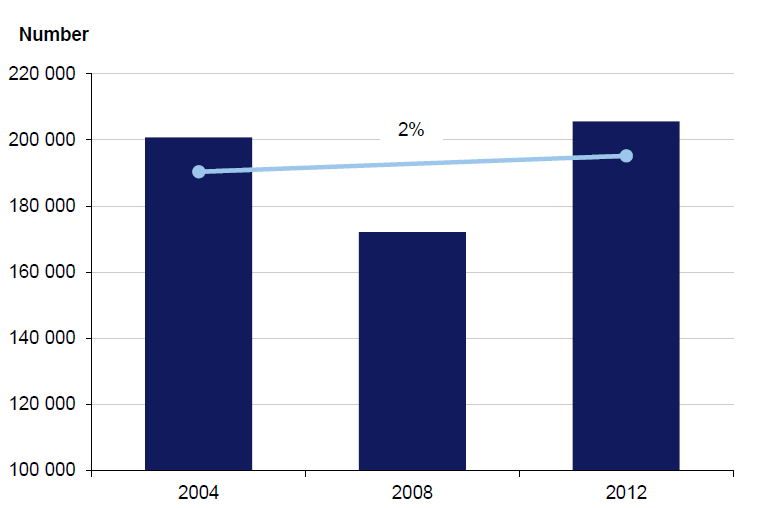
Source: Victorian Auditor-General's Office analysis of Victorian Registration and Qualification Authority data.
2.4.2 Apprenticeship and traineeship commencements
The number of people starting an apprenticeship or traineeship has fluctuated since 2004. Commencements peaked in 2011 when approximately 69 500 new students entered the system, but dipped to 66 000 in 2012. The 2012 commencements figure is higher than the 2004 figure but by fewer than 1 000 students.
The increases that have occurred can almost exclusively be attributed to trainees. Indeed, the number of new apprentices has fallen slightly since 2010.
As Figure 2D shows, trainees make up the majority of apprentice and trainee student commencements in Victoria. On average trainees make up 80 per cent of the total and apprentices make up 20 per cent. Figure 2D also shows that despite the fluctuations, traineeship commencements have been more than double the number of apprenticeship commencements each year between 2004 and 2012, and in fact were four times higher in 2011 and 2012.
Figure 2D Apprentice and trainee (student) commencements, 2004–12
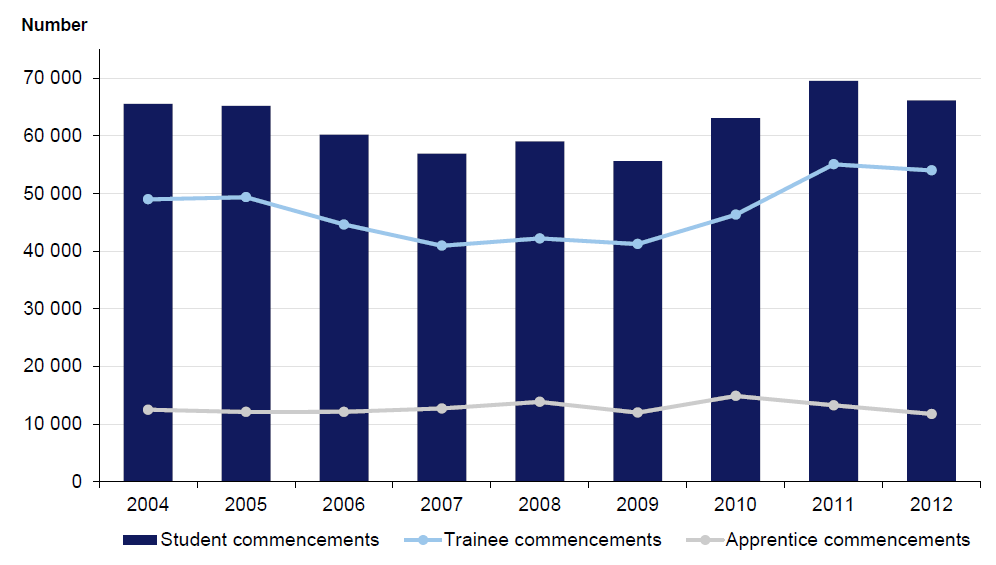
Source: Victorian Auditor-General's Office analysis of Victorian Registration and Qualification Authority data.
2.4.3 Student completion rates
The student completion rate measures the overall proportion of a group of students who commence training in a given year, and go on to complete. In determining the completion rate, it is important to allow sufficient time to ensure that all students can be included in the calculation. Given this, it was only possible to calculate completion rates for students who commenced prior to 2009 at the time this report was published.
Figure 2E shows that the completion rate has remained fairly constant since 2004. Fluctuations in the number of people commencing each year means that the total number of people completing varied, however, the proportion of people who completed has remained the same. Despite the increasing investment from the state government approximately 38 per cent of apprentices and trainees don't complete their qualification.
Figure 2E Completion rate for apprentices and trainees who commenced training between 2004 and 2008
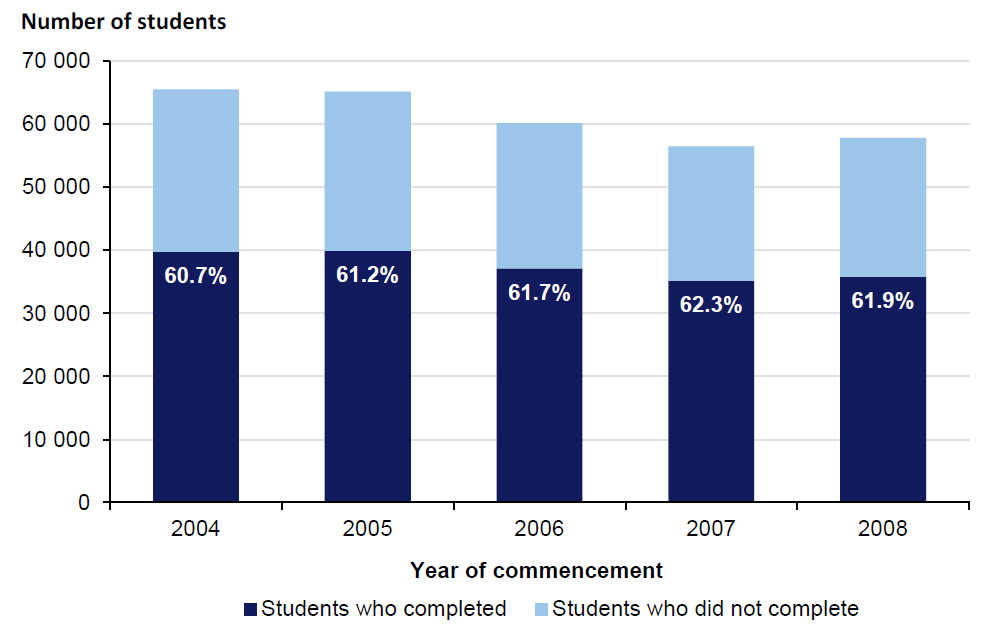
Source: Victorian Auditor-General's Office analysis of Victorian Registration and Qualification Authority data.
2.4.4 Qualification completion
The student completion rate is important, however, given that people can study multiple qualifications simultaneously or sequentially, the total number of qualifications completed can also provide useful insight. It shows the number and percentage of qualifications being attained as opposed to the number of people attaining these qualifications.
Figure 2F shows the number of apprenticeships and traineeships started between 2004 and 2012, and the number of those qualifications that were completed by 2008.
Figure 2F Apprenticeship and traineeship qualifications, 2004–12
|
Year |
Number of qualifications commenced |
Number of qualifications completed |
Qualification completion rate (per cent) |
|---|---|---|---|
|
2004 |
79 276 |
41 396 |
52 |
|
2005 |
79 861 |
42 813 |
54 |
|
2006 |
74 858 |
41 208 |
55 |
|
2007 |
71 525 |
39 959 |
56 |
|
2008 |
75 086 |
42 454 |
57 |
|
2009 |
72 546 |
NA |
NA |
|
2010 |
85 548 |
NA |
NA |
|
2011 |
96 503 |
NA |
NA |
|
2012 |
91 931 |
NA |
NA |
Source: Victorian Auditor-General's Office analysis of Victorian Registration and Qualification Authority data.
This shows that the number of qualifications being completed has fluctuated, but that the rate at which students are completing qualifications has consistently grown. If this trend continues, higher numbers of qualifications will be attained, and emerging completion data indicates that this is indeed taking place.
Figure 2F also shows that the number of apprenticeship and traineeship qualifications started has grown notably since 2009. This is potentially a result of the Victorian Training Guarantee in 2009. One objective of the Victorian Training Guarantee was to increase the number of people undertaking training at higher levels—a process DEECD refers to as 'upskilling'—and in areas where skills are needed.
The increase in the number of apprenticeships and traineeships qualifications being started each year suggests that DEECD is achieving part of its objectives—individuals are pursuing more qualifications.
However, when considered in relation to Figure 2D, the lack of comparable growth in the overall student numbers suggests its objective of having more people undertake vocational education and training is not being achieved.
2.4.5 Differences in completion patterns
Returning to the data on individuals, our analysis identified that completion rates for apprentices are quite different to those for trainees.
Figure 2G
Completion rate for apprentices and for trainees who started training between 2004 and 2008
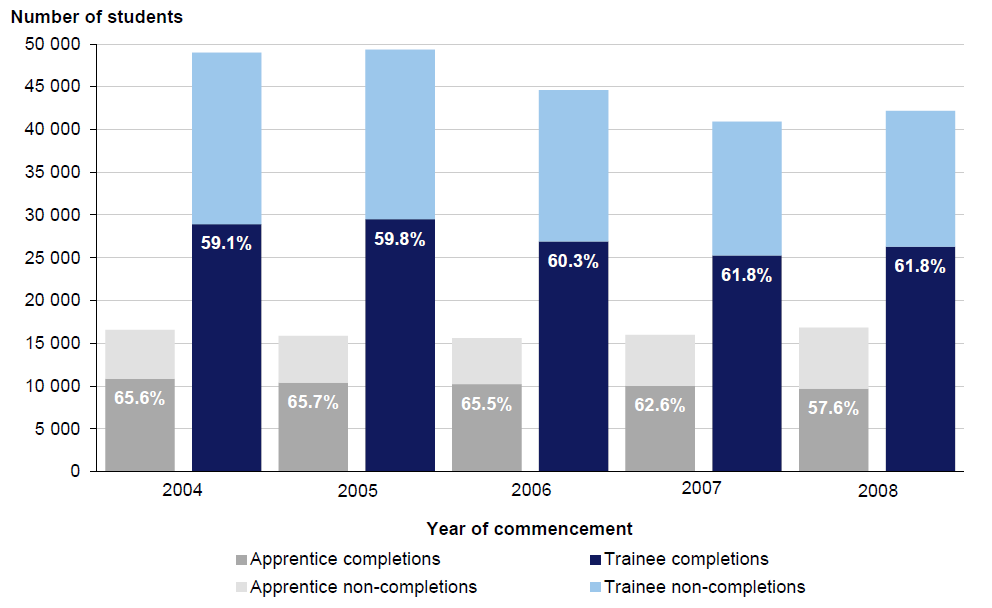
Source: Victorian Auditor-General's Office analysis of Victorian Registration and Qualification Authority data.
The apprenticeship completion rate was higher than the trainee completion rate for four of the five years illustrated in Figure 2G. A potential factor contributing to this is that for some fields—such as electrical and plumbing—workers need to complete an apprenticeship to achieve a licence to work, whereas trainees do not. However, as Figure 2G also illustrates, apprenticeship completion rates have trended downwards. This is likely to be a result of the global financial crisis, which began to take effect from 2008, impacting the apprentices that commenced in that year.
The traineeship completion rate has followed the opposite trajectory, steadily increasing among students who started from 2004 onwards. Trainees are now more likely to complete than apprentices. The fact that the trainee completion rate increased over this period illustrates that apprentices and trainees are influenced by different factors, and highlights the strong need for DEECD to analyse its data on participation and completion.
2.4.6 Most frequent outcomes of apprenticeships and traineeships
The majority of apprentices and trainees who started between 2004 and 2008 either:
- completed their apprenticeship or traineeship with the employer they started with—47 per cent, 135 603 people
- gave up and left the apprenticeship and traineeship system altogether—34 per cent, 96 899 people.
Of the remaining 55 326 people who changed either their employer or course at least once during their apprenticeship or traineeship, almost three-quarters went on to complete.
This analysis suggests the largest cohort in the apprenticeship and traineeship system that DEECD can target to improve completions is the 34 per cent of people who cancel their first and only contract. DEECD should develop a better understanding of the reasons why these apprentices and trainees walk away, so it can identify opportunities for better targeted support.
Figure 2H Outcomes for apprentices and trainees who started training between 2004 and 2008
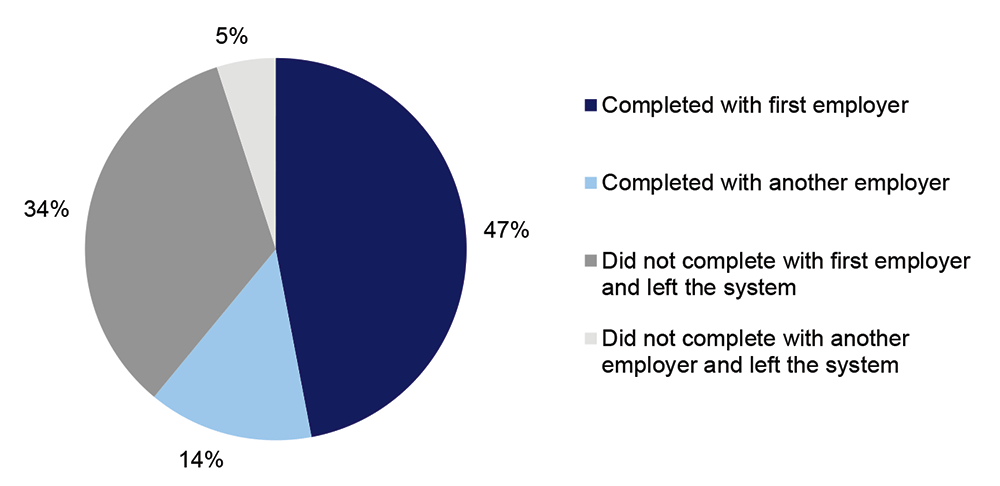
Source: Victorian Auditor-General's Office analysis of Victorian Registration and Qualification Authority data.
These outcomes differ for apprentices and trainees. While 20 per cent of apprentices sought work with another employer and completed their qualification, only 13 per cent of trainees did the same. Thirty-six per cent of trainees left the system altogether after their first employer, rather than seeking work elsewhere and completing their qualification, compared with 27 per cent of apprentices.
Further analysis of apprenticeship and traineeship data is available in Appendix A.
3 DEECD's activities to influence completion
At a glance
Background
The Department of Education and Early Childhood Development (DEECD) is the major government agency responsible for apprenticeship and traineeship funding, policy and program delivery in Victoria. It has significant capacity to influence apprenticeship and traineeship completion.
Conclusion
DEECD is not maximising apprenticeship and traineeship completion by addressing the issues known to influence it. Changes to government funding have contributed to people enrolling in more apprenticeship and traineeship qualifications. However, there has been little change in student completion rates.
DEECD's program to support first-year apprentices is positive, but valuable opportunities to influence the completion rate are being missed. DEECD's lack of action and the stagnant nature of the completion rate raises questions about whether government is getting the most from its investment in this area.
Findings
- DEECD has not developed programs to address known areas of influence.
- DEECD uses funding to training providers as the major lever for completion. There is no evidence that this is achieving a higher completion rate.
- The Apprenticeship Support Officer program is DEECD's main program to influence completion, and early results are promising. Extending it further could potentially produce more benefits.
- DEECD has not developed any programs aimed at employers, despite workplace issues consistently being identified as the major influence on completion.
Recommendations
DEECD should:
- develop and implement a process to collect, analyse and report data
- identify strategies to improve the completion rate.
3.1 Introduction
Successful apprenticeships and traineeships require the cooperation of multiple parties, including Commonwealth and state governments, industry associations, employers, apprentices, trainees and registered training organisations. As a consequence, there are a broad range of factors that influence whether individuals complete apprenticeships and traineeships—ranging from personal circumstances, to workplace factors to broader economic conditions.
The Victorian Government is the major source of funding for apprenticeships and traineeships in Victoria. The Department of Education and Early Childhood Development (DEECD) administers funding, develops policies and guidance and is ultimately responsible for the effective operation of apprenticeship and traineeship programs in Victoria.
To fulfil this role, DEECD needs to have a thorough understanding of trends in participation and completion, and the factors influencing them. This would allow DEECD to clearly differentiate between the factors that it has some power to influence, and those—such as broader economic and employment conditions—that it has limited power to influence. Armed with this knowledge, DEECD would be better placed to develop effective programs that ensure:
- the government can prudently target its activity and realise value for its investment
- industries' skills needs are being met
- individuals are developing skills and acquiring qualifications to facilitate their ongoing participation in the workforce.
This part examines whether DEECD has made best use of available funding, information and research to target its efforts and maximise completions.
3.2 Conclusion
There are notable gaps in DEECD's activities to influence apprenticeship and traineeship completion, particularly in critical areas that are known to have a direct impact on completion and are within its power to influence. As such, DEECD is doing little to maximise apprenticeship and traineeship completions.
DEECD argues that the government funding model is its primary mechanism for influencing completion. While funding appears to have led to more people starting apprenticeships and traineeship qualifications, there is a lack of evidence to suggest that the funding model has any bearing on individuals' decisions to complete. While DEECD continues to focus on this activity, the apprenticeship and traineeships completion rate is likely to remain stagnant.
Encouragingly, DEECD has recently worked to influence completion by developing the Apprenticeship Support Officer program. This program is based on solid evidence of what is effective and is having promising early results. However, it has limited reach and is currently not funded to continue beyond 2014. Meanwhile, other opportunities to focus action and potentially improve completion rates—such as programs targeting employers—are being missed.
DEECD is also missing important opportunities to develop targeted programs to increase completion by not tracking individuals once they exit the system. The lack of understanding of why individuals do not complete their apprenticeship or traineeship, compounds DEECD's poor grasp of apprenticeship and traineeship participation and completion data.
3.3 Factors that influence completion
There are multiple factors that influence whether an individual will complete their apprenticeship or traineeship. These range from personal circumstances and job satisfaction through to broader economic conditions. While DEECD's lack of analysis of apprenticeship and traineeship data means it has a limited understanding of trends in actual participation and completion patterns, it has worked to develop a solid understanding of these influencing factors.
Since 2009, it has commissioned eight reviews of different aspects of apprenticeships and traineeships, some of which touched on completion:
- A 2012 survey of bullying and harassment of apprentices and trainees concluded that reducing the incidence of bullying and harassment would increase retention and completion rates.
- A 2011 analysis of apprenticeship cancellation in Victoria highlighted that changes in job circumstances—such as changing employer, a shortage of work and pursuing other work—were most frequently cited as the reasons for cancelling an apprenticeship or traineeship.
- A 2009 review of pastoral care for apprentices highlighted the importance of being able to access support at key stages—such as the first six months of training—and recommended there be consistency in who provides support and advice to apprentices and employers at all stages of the apprenticeship.
Using information to inform program activity
This work to understand the broad factors that influence apprenticeship and traineeship completion is positive, and has led to actions designed to influence completion. DEECD's 2009 report on pastoral care directly informed the development of the Apprenticeship Support Officer program. This is a key initiative aimed at improving retention and completion. The 2009 report also underpinned DEECD's attempts to advocate for the transfer of control of Australian Apprenticeship Centres to the state as a single point of contact with government for apprentices and trainees. While the Commonwealth Government has since decided not to proceed with this transfer, DEECD continues to advocate for a single point of contact, informed by research indicating this could enhance the effectiveness of the system.
3.3.1 Gaps in DEECD's activities to influence completion
When considering the gaps in DEECD's approach, it is important to note that apprenticeships and traineeships sit within a national context that involves the participation of multiple government agencies and statutory authorities. It is appropriate for work performed by other agencies—such as the provision of financial incentives by the Commonwealth Government—to shape DEECD's decisions around where to intervene. However, the stagnant nature of completion rates in Victoria over recent years highlights that further action to increase completion rates is needed.
Inaction in response to research and review findings
DEECD's attempts to understand how it can influence apprenticeships and traineeships are positive. However, DEECD's research highlighted a range of influencing factors that it has not acted on.
For example, the 2011 analysis of apprenticeship cancellations recommended that DEECD draw on information in cancellation forms to develop a standardised data collection. This could then be monitored and used as an evidence base to develop retention strategies. No action has arisen in response to this recommendation.
Similarly, the 2009 review of pastoral care recommended that employers of apprentices be registered, and that their workplaces be validated for their capacity to offer the breadth of training and work opportunities apprentices required. Again, no action has been taken to implement this.
DEECD's lack of action in response to these findings and recommendations represents missed opportunities to increase completion rates.
3.3.2 Inaction in critical areas
Lack of action focused on employers
A notable gap in DEECD's approach is its lack of activity to work with and influence employers. Apprentices' and trainees' experience of work is the most influential factor in their decision to complete.
The Commonwealth Government's expert panel on apprenticeships found that 'a significant proportion of attrition in apprenticeships and traineeships stems from problems with the workplace or employer'. The importance of this relationship was also consistently and overwhelmingly confirmed by the apprentices consulted as part of this audit. Apprentices were unanimous in the view that their work and workplaces were central to their decisions to complete.
Despite this, DEECD has not developed any initiatives or programs aimed at employers to facilitate successful apprenticeships and traineeships. While acknowledging that there are limitations on the extent to which DEECD can influence employers, the demonstrated relationship between workplace experience and completion means it is important for DEECD to be active in this space.
Lack of student tracking after training
DEECD has little understanding of the outcomes of apprenticeships and traineeships. It asserts that participation in apprenticeships and traineeships can benefit individuals regardless of whether they complete. However, it does not track or follow up on apprentices and trainees, regardless of whether they completed or not. DEECD therefore cannot determine the relative benefits of completion and non-completion for Victorian:
- individuals—in the form of work stability and remuneration
- employers—in the form of sufficiently skilled workers
- government—in the form of value for money spent on training.
National Centre for Vocational Education Research reports provide limited information of this kind at a national level, but do not provide specific information on Victorian apprentices and trainees.
DEECD also has limited insight into whether apprentices and trainees who do not complete go on to work or further training, and it has no understanding of their ongoing workforce participation patterns. This is a significant gap and means DEECD does not know whether its claim that non-completion can still lead to positive outcomes is founded.
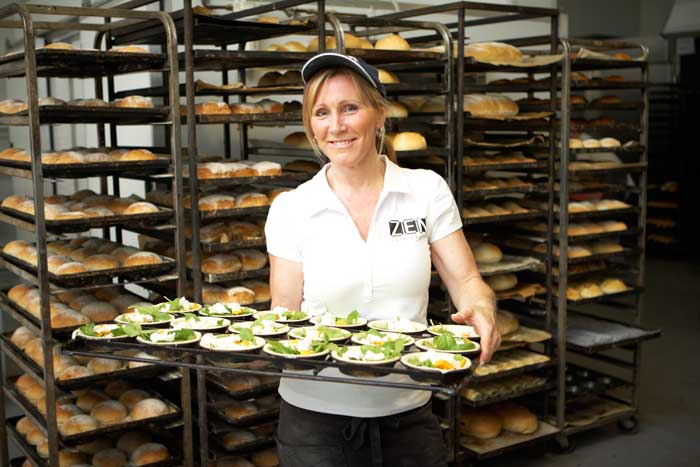
Photograph courtesy of VRQA.
Removing financial incentives
DEECD has recently discontinued financial incentives to encourage participation in, and completion of, apprenticeships and traineeships. This is despite inconclusive evidence as to their impact on completion.
A range of financial incentives, largely provided by the Commonwealth Government, have previously been available to apprentices, trainees and their employers to encourage participation and completion. Historically, the Victorian Government has supplemented these incentives with two state-based programs:
- Apprenticeship Trade Bonus—apprentices received two $250 payments, one at the six-month stage of their apprenticeships, another at 12 months.
- Apprenticeship and Traineeship Completion Bonus—eligible employers of apprentices and trainees received payments of between $1 300 and $2 000 a year up to the nominal completion of their apprentice or trainee, and again when they completed.
Both of these incentives will cease after the 2014–15 financial year.
There is inconclusive evidence on the impact of incentives on apprenticeship and traineeship completion. A 2010 Victorian Government survey identified that 64 per cent of employers of apprentices and trainees agreed that financial incentives positively influenced their decision to hire apprentices and trainees. Forty-eight per cent agreed that financial incentives assisted them to help their apprentices and trainees to complete. DEECD attributes the notable increases in the apprenticeship and traineeship completion rate in 2004 and 2005 to the completion incentives that the Commonwealth introduced at that time.
In contrast, an analysis of the national Australian Apprenticeships Incentives Program, commissioned by the Commonwealth Government in 2012, found that for the most part retention and completion incentives were ineffective. This is consistent with feedback VAGO received from both apprentices and employers.
Despite this conflicting evidence about the effectiveness of incentives, DEECD has discontinued its state-based incentive programs without subjecting both programs to thorough review. This means that from 2015, DEECD will offer no incentives to employers or apprentices and trainees to encourage them to complete. DEECD is unaware of what the likely impact of this decision will be on completion rates.
Compounding this is the uncertain future of Commonwealth incentives given the:
- $850 million reduction in the Commonwealth Government's overall budget for apprenticeship and traineeship incentives that has yet to take full effect
- change of Commonwealth Government in late 2013.
3.4 How DEECD facilitates completion
Despite the gaps outlined in Sections 3.3.2 and 3.3.3, DEECD does work to facilitate completion by providing:
- funding for apprenticeship and traineeship training
- direct support for apprentices
- broader support and guidance for system participants.
3.4.1 Facilitating completion through funding
DEECD argues that the government funding it gives to training organisations to provide apprenticeship and traineeship training is its primary mechanism for influencing completion. However, there is no evidence to suggest that this is effective.
The current funding model
Apprenticeships and traineeships form part of the broader vocational education and training (VET) system and are funded within this context. VET funding arrangements underwent considerable reform between 2009 and 2012 designed to:
- open up the training market
- encourage more people to participate in training
- establish user choice around where training can take place.
Figure 3A Overview of the Victorian vocational education and training funding model
|
Prior to 2008 The government mainly funded publicly-owned technical and further education institutes to offer a fixed number of training places in specific qualifications. Post 2008 reforms Reforms removed the cap on the number of government-funded training places and allowed government funding to flow more freely to private training providers. The reforms were intended to lead to course offerings better reflecting student demand. Currently, DEECD funds both public and private registered training organisations to train as many students as enrol in a course—subject to student eligibility criteria, such as age and previous qualifications attained. The amount that DEECD pays depends on the qualification being undertaken. The courses the government understands to be of highest public value—such as those in areas experiencing skills shortages or deemed critical to the Victorian economy—receive the highest rate of funding. Courses considered to be of low public value or in areas with an oversupply of workers receive the lowest rate of funding. In theory, high rates of funding should translate to lower fees passed on to students. This is intended to send market signals to individuals to encourage enrolment in qualifications of greater public value. |
Source: Victorian Auditor-General's Office.
Two components of the funding model work to encourage participation in apprenticeships above all other VET qualifications:
- All apprenticeship qualifications are in the top funding band, attracting the highest rates of funding, which should lead to comparatively lower fees for students.
- No eligibility requirements are imposed on individuals seeking to enrol in apprenticeships. This means that anyone can enrol in a government-funded apprenticeship regardless of age and other qualifications they may have attained.
The funding model is designed to reduce the costs of participation in apprenticeships and encourage people to pursue them. Early indications suggest that this is having mixed results, as set out in Part 2 of this report. Figure A in the Audit summary and Figure 2F show that in 2012, apprenticeship and traineeship qualification commencements were 16 per cent higher than in 2004, but the number of people undertaking apprenticeships and traineeships is virtually unchanged.
It is too early to determine the completion rate of apprentices and trainees who commenced training from 2009 after the new funding model was introduced. However, the completion rate saw minimal change between 2004 and 2008, hovering at around 62 per cent. This means a considerable proportion of government investment in apprenticeships and traineeships does not lead to a completed qualification. This has implications for business and industry and is important in determining whether the government is getting an appropriate return on its investment.
DEECD's focus on encouraging people to participate in apprenticeships and traineeships rather than on increasing the proportion who complete raises questions about the value for money being derived from its growing investment in apprenticeships and traineeships.
3.4.2 Facilitating completion through information and support
Apprenticeship Support Officer program
DEECD's key program aimed directly at encouraging completion is the Apprenticeship Support Officer (ASO) program. It is funded by the Commonwealth Government under the Council of Australian Governments' National Partnership on Youth Attainment and Transitions, but was designed and is managed by DEECD.
The ASO program is a response to the findings of a 2009 report on pastoral care for apprentices which found that apprentices—particularly those aged under 24—are most vulnerable in their first year, and most likely to disengage from training within the first six months.
The ASO program therefore targets first-year apprentices aged under 25. There are 27 ASOs employed across 12 technical and further education institutes in Victoria. ASOs make contact with all first-year apprentices and, following an initial assessment, provide ongoing support for those deemed to be most at risk of disengaging. This assessment considers factors such as:
- whether the apprentice has completed year 12 or equivalent
- whether the apprentice has a disability
- whether the apprentice is from a culturally or linguistically diverse background
- the industry they are working in.
A 2011 review of the ASO program found that it was well received by stakeholders and that apprentices felt it had positively influenced them to continue with their apprenticeship. These are promising early results. However, it is too early to tell whether it is having lasting benefits that will translate into improved completion outcomes. The ASO program is currently the subject of another review commissioned by DEECD, and it will be important for DEECD to pay close attention to these emerging findings.
There are some issues with the program that limit its reach and influence on completion rates:
- Support is not available to trainees, meaning that less than 20 per cent of students are entitled to support.
- Support is not available to apprentices over the age of 25. This means that 20 per cent of new apprentices—almost 5 000 people in 2011 and 2012—were not able to access support from an ASO.
- Funding is not guaranteed beyond 2014. After this time, Victoria may be without a dedicated program aimed at improving apprenticeship completion rates.
Despite these limitations, the ASO program is a noteworthy initiative. It stands alone as a program seeking specifically to influence completion and is based on strong evidence. The early indications of positive results in the 2011 review are a good outcome for DEECD and show the benefits of targeting efforts to areas that evidence and research indicate are effective points of intervention. As a Victorian-designed program, there is also scope for other jurisdictions to learn from this approach.
3.4.3 Information and guidance for participants
Multiple agencies, including DEECD, the Victorian Registration and Qualifications Authority and the Commonwealth Government through Australian Apprenticeships Centres, provide a range of information and guidance to apprentices and trainees to assist them throughout their training. However, this information is not well coordinated, resulting in considerable duplication.
The provision of information and guidance plays an important role in participation and completion as it helps people choose the right training option and navigate the system.
The right information about training options, workplace conditions and career pathways prior to sign-up can help people make the right choice. Similarly, the right guidance and advice during training can assist apprentices and trainees to stay on track when they are considering exiting the system.
Currently, there is no formal coordination of the provision of information and guidance, or any single party providing oversight of individuals' participation in all stages of the apprenticeship and traineeship system. As a result, materials are duplicated and more importantly, there is no single definitive source of information, which can lead to confusion among participants.
DEECD makes efforts to overcome the fragmented nature of the system by providing significant amounts of information through the Victorian Skills Gateway website. This website is a comprehensive resource about VET training options, skills shortages and regional industry and training profiles, designed to assist participants make prudent decisions about the best training option for them.
The Commonwealth-run Australian Apprenticeships Centres also play a critical role in providing information to apprentices and trainees at the sign-up stage and they also publish considerable volumes of information online. They do so with minimal input from DEECD.
DEECD has recognised that this fragmented approach is likely to have an adverse impact on completion and over the past year has worked consistently with the Commonwealth to achieve a single, coordinated approach to providing information and guidance to apprentices and trainees. However, the Commonwealth did not agree to the state's suggested approach of transferring responsibility for Australian Apprenticeships Centres to the states. This issue remains unresolved, and in the meantime, DEECD has not developed an alternative approach.
Recommendations
That the Department of Education and Early Childhood Development:
- collaborate with the Victorian Registration and Qualifications Authority to develop a functional database to replace its existing database, DELTA
- develop and implement a structured process to collect, analyse and report on data including:
- the participation of apprentices and trainees in training, including factors influencing both commencement and completion
- the type and level of training being undertaken, matched against known industry needs
- the destinations and outcomes of apprentices and trainees after they exit the system
- identify strategies to improve the completion rate, including by targeting people who do not complete with their first employer and exit the system
- develop or engender mechanisms to provide support for all apprentices and trainees, pending evaluation of the Apprenticeship Support Officer program.
4 Regulation of apprenticeships and traineeships in Victoria
At a glance
Background
Effective regulation is a key part of a well-functioning training system. The Victorian Registration and Qualifications Authority (VRQA) assumed responsibility for regulating apprenticeships and traineeships in late 2012.
Conclusion
VRQA is in the early stages of implementing a new regulatory model, designed to address the risks and weaknesses it identified when it took over responsibility for regulating apprenticeships and traineeships. It is too early to fully assess the effectiveness of the new model, or whether it will have a positive impact on completion rates. However, there are a range of issues that VRQA needs to address to facilitate effective regulation and contribute to successful outcomes for students. VRQA has committed to addressing these issues over the next 18 months.
Findings
- Apprenticeship and traineeship regulation is currently undergoing major change, but VRQA must prioritise the remaining areas of concern.
- Current regulatory requirements are not effectively communicated to apprentices, trainees and their employers, therefore creating impediments to compliance.
- Fundamental issues with the electronic register of apprentices and trainees significantly compromise VRQA's ability to effectively regulate the system. However, work to introduce a new register has already commenced.
- VRQA does not have a rigorous approach to assessing the suitability of employers to hire apprentices and trainees.
Recommendations
That VRQA:
- in collaboration with the Department of Education and Early Childhood Development, prioritise development of a register of apprentices and trainees
- develop a more robust employer approval process that gives due consideration to whether employers are fit and proper.
4.1 Introduction
Employers have important obligations to provide their apprentices and trainees with a safe working environment, to ensure they receive adequate on‑the‑job training and are given adequate time to attend off‑the‑job training. Equally, apprentices and trainees have obligations to meet employers' expectations around work attendance and performance, as well as obligations to attend off‑the‑job training. These requirements are set out in the training contract cosigned by the employer and the apprentice or trainee.
The Victorian Registration and Qualifications Authority (VRQA) regulates apprenticeships and traineeships. It assumed this responsibility from the former Victorian Skills Commission on 1 October 2012. Its key regulatory functions include:
- determining approved training schemes
- approving employers before they employ an apprentice
- the administration of training contracts
- approving the cancellation, suspension or amendment of training contracts
- resolving disputes between employers and apprentices or trainees.
This Part examines the robustness of VRQA's regulatory activities and the impact of these activities on student completions.
4.2 Conclusion
Prior to assuming responsibility for regulating apprenticeships and traineeships, VRQA identified the risks in the regulatory practices. It has commenced work to address the risks it identified and to enhance the effectiveness of its regulation of apprenticeships and traineeships. It is too early to determine the impact of these changes.
Nevertheless, considerable further work is needed to strengthen regulation and give apprentices and trainees the best chance of achieving a successful outcome. Key areas for improvement include:
- urgently upgrading the register of apprentices and trainees
- enhancing communications around the changed regulatory environment
- developing processes to ensure employers of apprentices and trainees are fit and proper.
VRQA has committed to address these issues over the next 18 months.
4.3 Recent changes to regulation of apprenticeships and traineeships
The transferral of regulation responsibilities to VRQA occurred in response to the findings of a 2011 review of apprenticeship and traineeship regulation undertaken by the then Department of Innovation, Industry and Regional Development. This review recommended that regulation be separated from policy development and broader system administration, in keeping with better practice. As a result, VRQA became the single regulator responsible for apprenticeships and traineeships, including registering and regulating training providers.
Following the announcement of the revised regulatory arrangements, VRQA:
- commissioned a due diligence report in February 2012
- delegated authority for regulation back to the Department of Education and Early Childhood Development (DEECD) in October 2012 in order to establish appropriate systems and frameworks to enable effective operation
- assumed full responsibility for regulation from 1 January 2013.
Revised regulatory field services
Central to the regulation of apprenticeships and traineeships is the provision of field services. Primarily carried out by Apprenticeship Field Officers (AFO), field services involve:
- providing information on the operation of the system to participants
- resolving minor issues
- progressing more significant issues towards dispute resolution.
In carrying out these duties, AFOs interact directly with apprentices, trainees and employers at critical points, where the risk of disengaging is at its greatest. This makes them an invaluable resource in supporting the successful completion of apprenticeships and traineeships.
The due diligence report VRQA commissioned in 2012 highlighted major risks with the existing field services model. AFOs had excessive caseloads—on average each AFO was responsible for regulating 1 868 employers, 2 608 apprentices and more than 4 000 trainees—limiting their ability to effectively perform their role. In response to these findings, VRQA outsourced field services. It commenced a tender process in November 2012 to find a service provider. The successful tender was announced in July 2013 and the contract commenced in September 2013.
It is encouraging that VRQA has identified and responded to this significant issue. However, the 10 months it took between starting the tender process and commencing the revised model mean that we have been unable to assess the impact of these revised arrangements. It is important that VRQA closely monitor performance from the point of view of both regulation and completion. The agreement between VRQA and the service provider sets out reporting and monitoring arrangements. This will allow it to ensure that regulatory field services are being carried out effectively. However, it is also important that VRQA fully utilise the information it receives to understand system performance from a broader perspective.
VRQA has agreed to regularly analyse information provided by field services. This information will form part of their reporting to the board from 2014.
4.4 Responding to residual issues
VRQA's action to address the major risks identified in the 2012 due diligence report signals its commitment to enhancing system regulation. However, this audit identified a range of other concerning issues that require prompt action. Given this, VAGO wrote to the VRQA board in November 2013 highlighting the identified issues, recommending remedial action and seeking specific advice as to how and when VRQA would address them.
A brief overview of the major issues and VRQA's planned action are outlined below.
The VRQA board uniformly accepted these recommendations and has committed to progressing action on each of them over the next 18 months. It is essential that VRQA follows through on the actions it has committed to, and makes much needed improvements to the regulation of apprenticeships and traineeships in Victoria.
Establish a functional apprenticeship and traineeship database
The most notable issue affecting VRQA's ability to effectively regulate apprenticeships and traineeships is Direct Entry Level Training Administration (DELTA), the database in which all apprentices and trainees are registered. Inadequacies with this system hamper DEECD's activities around planning and policy development for apprenticeships and traineeships.
Maintaining a register of apprentices and trainees is a legislative responsibility of VRQA under the Education and Training Reform Act 2006. Concerns have been raised repeatedly over the past four years about the accuracy, security, timeliness and scope of data that DELTA contains. However, these concerns have not been addressed. As a result, DELTA still:
- does not include signed training contracts
- does not include apprentice or trainee identification documents
- does not include employer declarations
- relies on manual data manipulation
- does not record changes made to the information it contains
- enforces character restrictions in fields for AFO comments.
These restrictions not only compromise VRQA's ability to fulfil its legislative obligations, but also limit opportunities to extract and analyse data to assist policy and program decisions. An updated system is urgently required.
VRQA have started planning for a replacement for DELTA. They are in the process of developing a business case for this significant project. Given the scale of this work, it is expected to take two years to complete and will require VRQA and DEECD to work together to ensure the future system meets the needs of all stakeholders. VRQA has committed to doing so, and to establishing appropriate project governance arrangements to ensure that this takes place. DEECD has also shown a commitment to collaborating on this work and has allocated $2.3 million towards it. The work undertaken to date and DEECD's allocation of funds are strong indications that this necessary work will proceed and result in a replacement of DELTA.
Formalise relationships with critical stakeholders
Several state and Commonwealth Government agencies are involved in providing information and services to participants in the Victorian apprenticeship and traineeship system, most notably:
- Australian Apprenticeships Centres
- WorkSafe Victoria
- Fair Work Australia
- DEECD.
How effectively these agencies fulfil their roles directly impacts on participants' compliance and therefore the regulatory action required of VRQA.
Currently, VRQA does not have any documented agreements with these agencies that clearly set out roles, responsibilities and expectations. The absence of such agreements creates the risk that the roles will not be fulfilled, compromising VRQA's ability to effectively regulate apprenticeships and traineeships.
VRQA has agreed to develop memoranda of understanding with each agency, setting out roles and responsibilities and information sharing protocols. This work will be completed by July 2014.
Improve employer approval processes
VRQA is required to approve employers seeking to enter into contracts with apprentices and trainees. This includes the requirement that supervisors of apprentices and trainees be fit and proper for that purpose—particularly important given the entry-level nature of apprenticeship and traineeship employment and the potentially vulnerable nature of this cohort.
VRQA's current employer approval practices are in effect an administrative self‑assessment. They provide little assurance that employers are fit and proper, or that they have the appropriate skills to be employers of apprentices and trainees.
Further, the strong impact that employers can have on apprentice and trainee completion means that the lack of rigour in assessing employer suitability could be adversely affecting completion.
VRQA notes that this is an important issue and is currently considering a revised approach. It has committed to adopting a new employer approval process by September 2014.
Update risk assessments and action plans
The due diligence report VRQA commissioned in 2012 identified 82 risks to VRQA's ability to fulfil its newly inherited obligations—48 per cent of which were classified as significant. While its outsourcing of field services is intended to address a significant proportion of these risks, VRQA has yet to develop an implementation plan to address the outstanding risks. The major changes it has implemented throughout 2013 are likely to have altered the risk profile of some of the identified issues.
It is sensible for VRQA to revisit the risks identified in the due diligence report and identify actions necessary to mitigate them, or any revisions to their rating. VRQA needs to also develop a schedule of works to address the outstanding risks and any new risks.
VRQA has committed to undertaking this work by March 2014 through the Apprenticeship and Traineeship Subcommittee of its board.
Comprehensive, up-to-date information on the regulation of apprenticeships and traineeships
VRQA needs to effectively communicate the significant changes to the regulation of apprenticeships and traineeships to ensure that system participants are aware of the changes and are able to act in accordance with regulation.
Currently, there is no publicly available document aimed at providing participants with detailed, up-to-date information on the regulation of the apprenticeship and traineeship system.
It is important for VRQA to develop and make publicly available a document setting out:
- objectives for the regulation of apprenticeships and traineeships
- roles and responsibilities of all parties, including escalation points
- common problems, their solutions and who to contact for more information.
VRQA has agreed to do so by July 2014.
Recommendations
- Due to ongoing change over the short to medium term, it is essential that the Victorian Registration and Qualifications Authority document and make publicly available comprehensive information about its regulation of apprenticeships and traineeships to facilitate regulatory compliance and the effective operation of the system. The document should include details of:
- objectives for regulation of apprenticeships and traineeships
- roles and responsibilities of all parties, including escalation points
- common problems, their solutions and who to contact for more information.
- That the Victorian Registration and Qualifications Authority, in collaboration with the Department of Education and Early Childhood Development, prioritise development of a secure register of apprentices and trainees which includes all the information required to meet the Department of Education and Early Childhood Development and the Victorian Registration and Qualifications Authority's needs in relation to planning, policy development and regulation of apprenticeships and traineeships in Victoria.
- The Victorian Registration and Qualifications Authority should develop memoranda of understanding—documenting information sharing protocols and roles and responsibilities—with:
- Australian Apprenticeships Centres
- WorkSafe Victoria
- Fair Work Australia
- the Department of Education and Early Childhood Development.
- That the Victorian Registration and Qualifications Authority develop a more robust employer approval process that gives due consideration to whether employers are fit and proper.
- That the Victorian Registration and Qualifications Authority, in addition to the monitoring and evaluation required under contract, develop arrangements to regularly analyse information collected through regulatory field services to identify improvement opportunities and inform policy and program development.
- That the Victorian Registration and Qualifications Authority review the risks identified in the due diligence report for:
- implementation of mitigation measures or risk treatment
- changes in risk rating
- identify emerging risks, following the changes the Victorian Registration and Qualifications Authority has made to the apprenticeship and traineeship regulation system
- develop a schedule of work to address these new and residual identified risks.
Appendix A. Further data analysis
VAGO data analysis methodology
The commencement and completion trends detailed in this report were drawn from the Direct Entry Level Training Administration (DELTA) database, which holds information on all apprenticeship and traineeship contracts commenced, completed, cancelled, suspended, recommenced and in progress.
In order to identify completion rates for apprentices and trainees we focused on individuals' participation and completion using the student number assigned to individuals within the DELTA system. The key elements of our analysis were:
- grouping individuals into the earliest contract commencement year associated with their student number
- matching these commencing students with a list of completed students
- identifying the proportion of commencing students that were matched to completed students to determine the student completion rate.
In addition to this, we separated apprentices from trainees to determine participation and completion rates for these different cohorts. This Appendix contains the results of this analysis, and compares trends in the commencement and outcomes of apprentices and trainees as distinct groups.
It is important to note that we identified some individuals who participated in both an apprenticeship and a traineeship at some stage between 2004 and 2012. However, this cohort is small—6 per cent of all students in the system between 2004 and 2012. To avoid distorting the data by double counting these individuals in both the apprenticeship and traineeship categories, we excluded this cohort from the Figures included in this Appendix, and from Figure 2G in Part 2.
Separating apprenticeships and traineeships
Commencements
Changes in commencement numbers during 2004 and 2012 are predominantly caused by trainees. The number of apprentices commencing each year has remained consistent at approximately 12 000.
Apprenticeships attract the highest rates of state government funding to encourage more people to commence apprenticeships, however, Figure A1 shows that this has not been achieved. Trainee commencements have changed more significantly in recent years even though they attract lower levels of state government funding.
Figure A1
Apprentice and trainee commencements, 2004–12
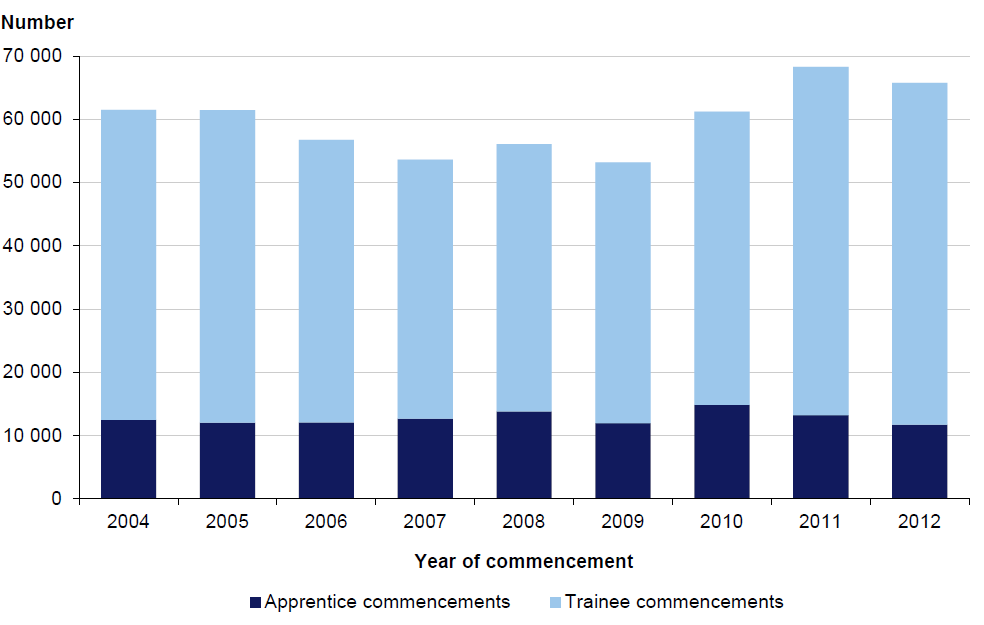
Source: Victorian Auditor-General's Office analysis of Victorian Registration and Qualifications Authority data.
Completion rate
The trend of the completion rate differs for apprentices and trainees. Between 2004 and 2007 apprentices had a higher completion rate than trainees, however, it decreased in both 2007 and 2008. In contrast, the completion rate for trainees has increased steadily. Trainees who commenced in 2008 had a higher completion rate than apprentices that commenced in the same year.
Figure A2
Completion rate of apprentices and trainees, 2004–08
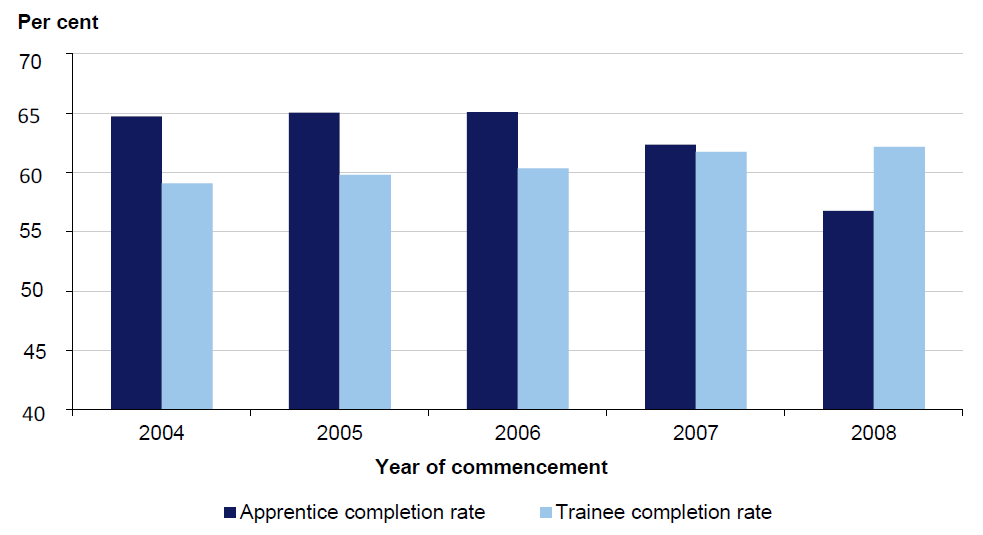
Source: Victorian Auditor-General's Office analysis of Victorian Registration and Qualifications Authority data.
Outcomes
A larger proportion of apprentices who commenced between 2004 and 2008 completed their qualification compared to trainees. The key difference between the pathways of apprentices and trainees is that a higher proportion of apprentices will continue their training with another employer. Thirty-six per cent of trainees did not complete with their first employer and left the system, compared to only 27 per cent of apprentices.
Figures A3 and A4 compare the outcomes of apprenticeships and traineeships.
Figure A3
Outcomes of apprentices who commenced between 2004 and 2008
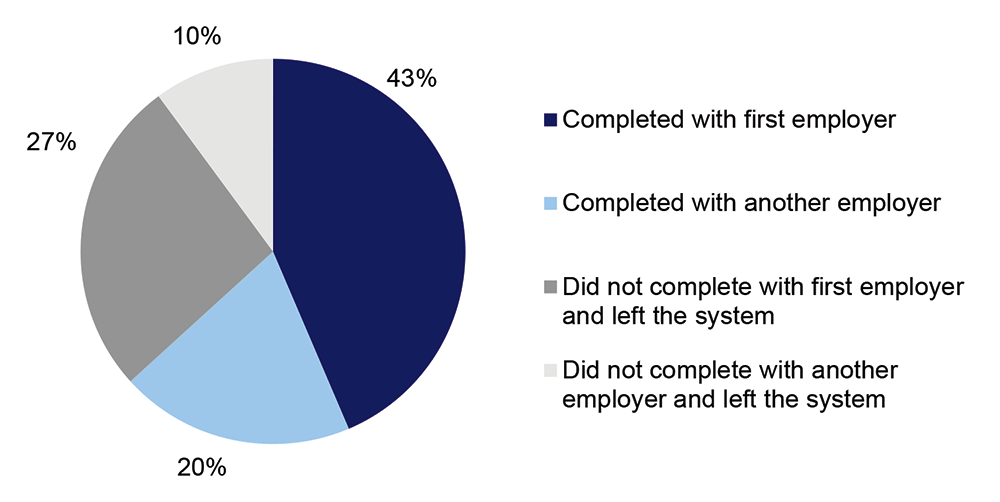
Source: Victorian Auditor-General's Office analysis of Victorian Registration and Qualifications Authority data.
Figure A4
Outcomes of trainees who commenced between 2004 and 2008
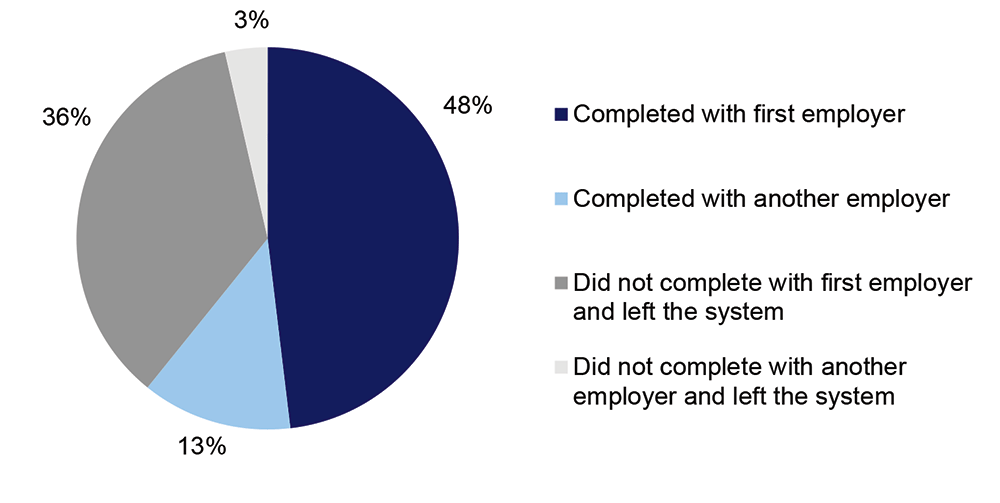
Source: Victorian Auditor-General's Office analysis of Victorian Registration and Qualifications Authority data.
Appendix B.Audit Act 1994 section 16—submissions and comments
Introduction
In accordance with section 16(3) of the Audit Act 1994 a copy of this report was provided to the Department of Education and Early Childhood Development and the Victorian Registration and Qualifications Authority with a request for submissions or comments.
The submissions and comments provided are not subject to audit nor the evidentiary standards required to reach an audit conclusion. Responsibility for the accuracy, fairness and balance of those comments rests solely with the agency head.
Responses were provided as follows:
- Department of Education and Early Childhood Development
- Victorian Registration and Qualifications Authority
RESPONSE provided by the Secretary, Department of Education and Early Childhood Development
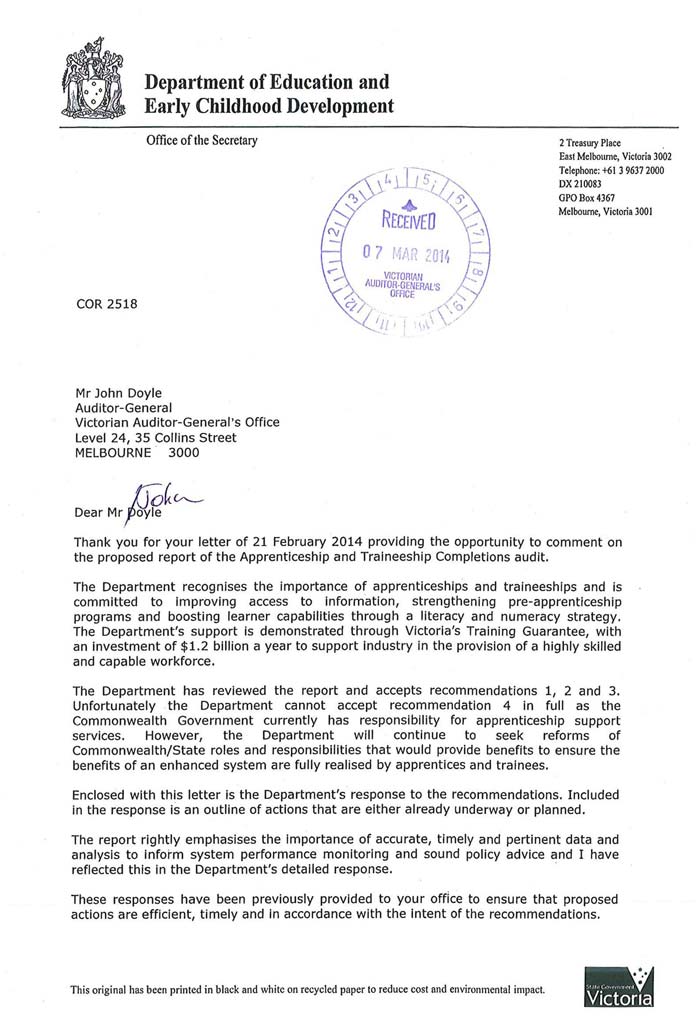
RESPONSE provided by the Secretary, Department of Education and Early Childhood Development – continued
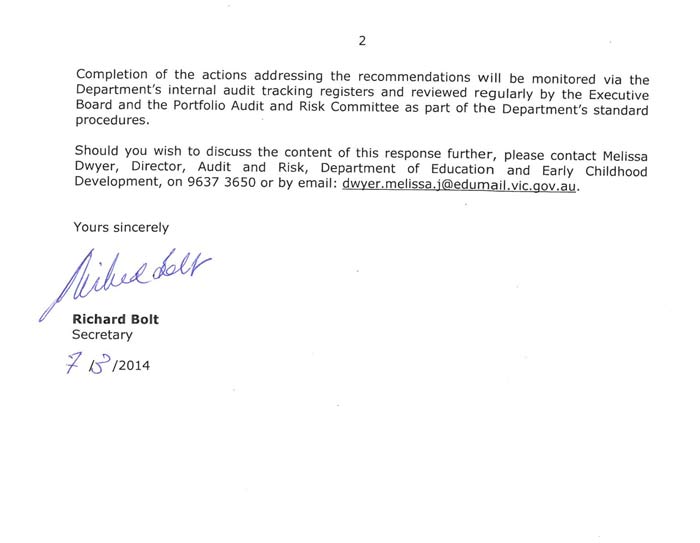
RESPONSE provided by the Secretary, Department of Education and Early Childhood Development – continued
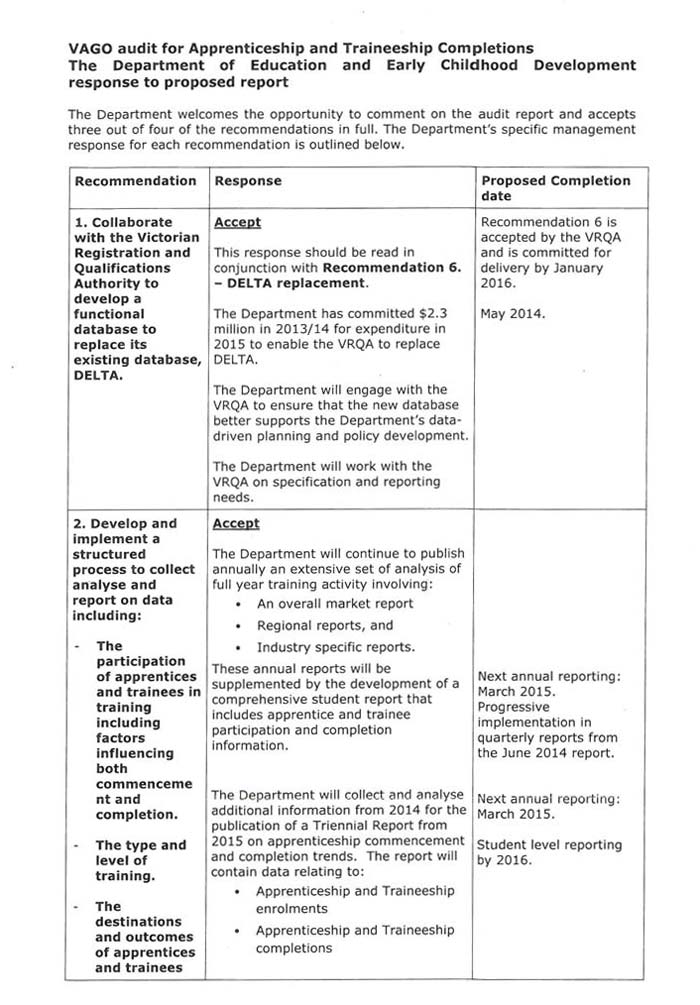
RESPONSE provided by the Secretary, Department of Education and Early Childhood Development – continued
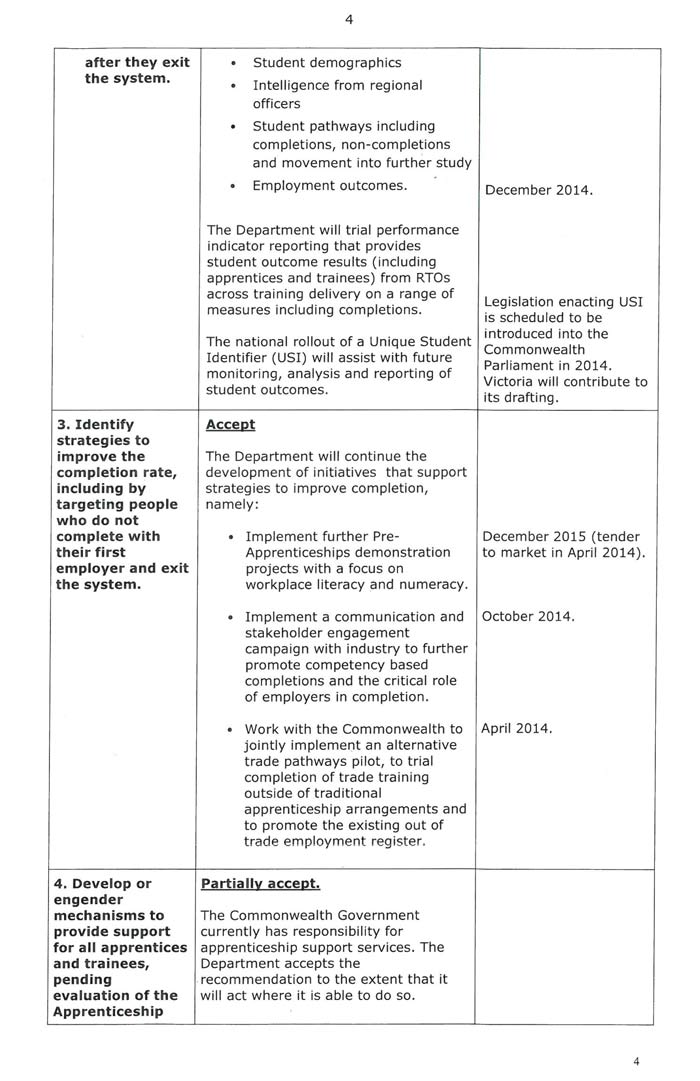
RESPONSE provided by the Secretary, Department of Education and Early Childhood Development – continued
